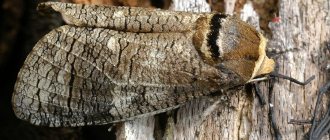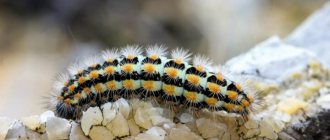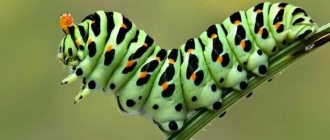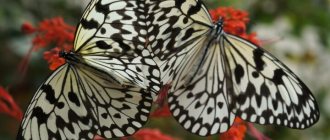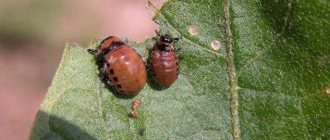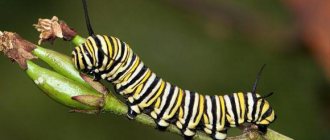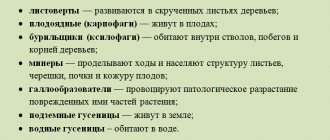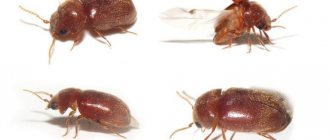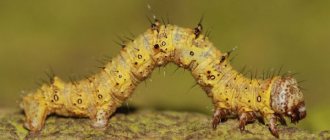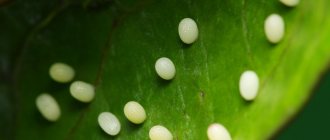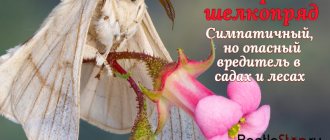Hairy caterpillars are a cause of human health problems. Sometimes the hairs contain poisons. 12 caterpillars from the families of moths and butterflies can cause serious injuries to humans, ranging from urticarial dermatitis, atopic asthma to osteochondritis, coagulopathy upon consumption, renal failure, intracerebral hemorrhage.
Skin rashes are the most common, and deaths have occurred. Lonomy is a common cause of disease in Brazil. From 1989 to 2005, 354 cases of disease from the hairy caterpillar were reported. The mortality rate from a bite is up to 20%, most often caused by intracranial hemorrhage.
Hairs cause keratoconjunctivitis. The sharp barbs at their ends can penetrate soft tissues and mucous membranes, such as the eyes. Once ingested, they are difficult to remove, exacerbating the problem of migration through the membrane.
Hairy caterpillars are a particular problem indoors. Hair easily penetrates ventilation systems and accumulates indoors due to its small size. This accumulation increases the risk of human contact.
Varieties (types) of caterpillars
The larvae of different butterflies look different, and their descriptions can vary significantly. Their features have developed in the process of evolution and help the caterpillar live and grow in the most favorable conditions for it, as well as protect itself from enemies.
Characteristics by which the larvae of different butterflies are classified:
- nature of nutrition;
- nocturnal or diurnal lifestyle;
- habitat;
- the structure of various parts of the body;
- availability of protective devices.
According to the position of the head relative to the body
According to the position of the head relative to the body, caterpillars are divided into several types:
- orthognathic (the longitudinal axis of the head and the axis of the body form a right angle);
- prognathic (the longitudinal axis of the flattened head continues the axis of the body);
- semiprognathic (occupies an intermediate position).
The first type is the most common, the second is typical for species with a mining lifestyle. They eat out passages and tunnels in the pulp of leaves and fruits. The third type includes caterpillars that live secretly.
According to the structure of the sole
The sole is the terminal part of the abdominal legs. It has hooks and a retractor muscle. With the help of these devices, the caterpillars can move along a vertical plane, upside down and in any direction. Based on their structure, there are two types of soles:
- the hooks are located along the edge, and the retractor muscle is in the center;
- hooks are present only on the inner side, and closer to the outer side there is a muscle, part of the outer edge is covered with keratinized tissue.
By type of nutrition (polyphages, monophages, oligophages)
Most caterpillars feed on various parts of plants. Depending on food preferences, they are divided into 3 groups:
- polyphagous (can live and feed on different types of plants, for example caterpillars of moths);
- oligophages (feed on several related plant species: the swallowtail larva loves dill, fennel, parsnips and other umbelliferous plants);
- monophages (their body is adapted to process only one type of plant: the silkworm feeds exclusively on mulberry leaves).
However, plants are not the only source of nutrition for small voracious creatures. Some of their varieties eat wood (xylophages), mushrooms (bagworm larvae), honey or beeswax (moth larvae), wool and leather (moth larvae).
Some rare species, such as the caterpillars of the bear butterfly and the cotton bollworm, eat not plants, but their fellows. They choose small, weakened individuals as victims.
By way of life (free or secretive)
According to their lifestyle, all caterpillars are divided into two groups: free-living and secretive. Free-living species are able to move through open spaces, for example from one plant to another. Some of them, especially poisonous ones, are painted in bright colors, while camouflage is important for others.
Secretive species prefer to live in a secluded place, out of public view. As a rule, such caterpillars have a nondescript color and are not armed with protective outgrowths.
Habitat of secretive caterpillars:
- soil (underground caterpillars);
- water (underwater caterpillars);
- leaves twisted in a special way (leaf rollers);
- pathological growths on stems or leaves (gall formers);
- pulp of fruits (codling moths), roots;
- wood (xylophages).
Nutrition
Hairy caterpillars in most cases eat plant foods - juices of fruits, plants, nectar. However, among them there are predators that eat their own kind - weakened, diseased larvae, butterflies, other small insects, and aphids.
- Polyphages are absolutely indiscriminate in their food, eating almost all vegetation. They lead a predominantly nocturnal lifestyle.
- Oligophages eat plants of a certain species or genus. Thus, the caterpillar of the swallowtail butterfly feeds exclusively on umbrellas.
- Monophages live and eat one plant. If a particular shrub is heavily infested, other plant species adjacent to it remain completely safe.
- Xylophages do not eat anything except wood. This group of caterpillars is always distinguished by a large number of individuals in one brood.
The transitional form is furry creatures that eat tinder fungi and lichens. A separate group includes keratophages, which feed on elements of animal origin - horny cover, wool, skin, hair.
Furry caterpillars
The hairy caterpillar butterfly is an ancient inhabitant of our planet, whose roots go back to the time of dinosaurs. There is a huge variety of larvae in the world, distinguished by their unusual appearance and the presence of body hairs of different lengths. A photo of the furry caterpillar is presented below.
The furry caterpillar may look quite attractive, but you should not touch it out of curiosity. In most cases, the hairs contain a special poison, which, when it comes into contact with the skin or wound, causes serious irritation of the skin, deterioration of general health - headache, chills, nausea, dizziness, etc.
Poisonous caterpillar
The unusual caterpillars were described in the scientific publication Science Alert. We are talking about the so-called cat moth caterpillars (Megalopyge opercularis). They are very common in the southeastern and central parts of the United States, as well as Mexico. They were not particularly found in Virginia, but in 2022 their numbers suddenly increased. In Russia it is impossible to stumble upon them, but lately the world has become unpredictable. No one really expected to see these creatures in Virginia either, but nature gave a surprise. And hardly anyone is happy about this surprise - the Internet is full of stories where these caterpillars caused terrible torment for many people.
The cat moth itself is also fluffy
Hairy caterpillars typically feed on oak and elm leaves, according to the state Department of Forestry (VDOF). But sometimes they can be found in parks and near buildings. The back of these creatures is covered with long hair-like bristles. At an early stage, these bristles begin to curl strongly and from a distance the caterpillars look like balls of fur. Under this thick hair there are poisonous thorns, which it is better for people and animals never to touch.
Purple Hawkmoth / Mimas tiliae
The small caterpillar reaches an average length of no more than 6 cm at the peak of development. The species of this inconspicuous butterfly was discovered by Carl Linnaeus in 1758.
The body is rough, and there is a horn on the tail. This horny process has a protective shield. Development begins in early summer. During this period, they can be found on the branches of wild and fruit trees. There are especially many of them on linden, birch, and various types of alder. By the time of pupation, the body color completely changes.
It is not dangerous in itself, but if it crawls across the body, it will leave a bright mark. There are substances on her body that cause an allergic reaction. It is most difficult for allergy sufferers and people with weakened immune systems.
Danger of caterpillars
It is not known what exactly toxic substances are contained in these thorns, but we know the consequences of contact with them. In almost all cases, people experience severe redness and swelling at the site of contact with the thorns. Some people also experience severe headache, fever, nausea, rapid heart rate, cramps and abdominal pain. As you can see, there is nothing good about contacting them.
Luckily, most caterpillars are harmless.
In some cases, contact with hairy caterpillars can land you in the hospital. In 2022, one of these caterpillars fell from a tree onto a 5-year-old girl, Adrie Chambers. The girl's arm went numb and she was taken to hospital where she was treated with steroids. In May 2022, one woman spoke about the consequences of her 5-year-old son stepping on a poisonous caterpillar. Such incidents happen almost every year, but this year there are clearly many more of them. However, this is not surprising - 2022 will shock us with might and main.
Caterpillars often get on clothes when falling from trees.
There are no such poisonous caterpillars in Russia, but if they appear or you ever go to the USA, you need to be prepared to encounter these creatures. The first thing to do after coming into contact with a hairy caterpillar is to stick a strip of tape to the skin and quickly tear it off. This way you can quickly get rid of poisonous thorns. If ailments occur, of course, you should not self-medicate. After all, we already know very well that most folk recipes do not bring any benefit? So, if you come into contact with any poisonous animal or plant, it is best to go to the hospital as soon as possible.
If you like our articles, subscribe to us on Google News! This will make it easier for you to keep track of new materials.
It is important to note that cat moth caterpillars are far from the only ones of their kind. Throughout Europe, as well as in Kazakhstan, Siberia and other regions of our planet, you can stumble upon the caterpillar of the female bear (Arctia caja). Most often you can come across them from September to May. These black caterpillars with long hairs can sting with caiine spikes. When contacting them, humans and other mammals experience so-called lepidopterism. This is the name for skin irritation that causes severe itching.
Saturnia io / Automeris io
The beautiful peacock butterfly is found in Canada and the United States. The entire body of the caterpillar of this butterfly is covered with peculiar greenish thorny pom-poms.
She herself is light, and does not grow more than 4–5 cm. You can only admire this view from afar, but under no circumstances pick it up or even touch it. After contact with the thorns, poison penetrates the body. Toxic substances cause redness, pain at the injection site and can even cause the development of dermatitis.
It looks like a very cute and safe creature. But this is yet another proof that beauty is deceptive.
Types of caterpillars with photos and names
Each type of butterfly has its own caterpillar. At the same time, the color of the caterpillar does not always match the color of the butterfly. In most cases, caterpillars are herbivores, although predatory species are also found. Depending on the food consumed, caterpillars are:
- Polyphages . These are caterpillars that indiscriminately eat any plant. This species includes moths such as the wine hawk moth, the ocellated hawk moth, the blind hawk moth, the kaya bear, moths, the peacock eye and others.
- Monophages are caterpillars that feed on one specific type of plant. These are cabbage grass, apple moth, silkworm and others.
- Oligophages are caterpillars that prefer to feed on one type of plant belonging to one species of family or type. These are butterflies: swallowtail, pine cutworm, polyxena, etc.
- Xylophages are a type of caterpillar that feeds on wood or bark. These include leaf rollers, woodworms and others.
Certain species of caterpillars inhabit subtropical regions, tropics, and northern regions. There are hundreds of species of such insects on the territory of each country. It is not by chance that caterpillars get their names. As a rule, they get their names depending on their main source of food. Some of the caterpillars were named so because they have a very interesting and intricate pattern on their wings.
Among all types of caterpillars, there are also valuable ones, such as the silkworm. Many caterpillars have a similar property. As the caterpillar moves, a thin thread remains behind. This thread serves as a kind of insurance in case an insect falls.
Interesting to know! Silk thread is obtained from the cocoon of the silkworm butterfly, after which silk fabric is woven from it, and then various products are sewn.
There are caterpillars up to 1 mm in size, as well as caterpillars more than 12 cm long. Among them there are quite beautiful specimens, completely inconspicuous, hairy, poisonous, and also those that can change their coloring during their development.
The following species are widespread in Russia:
- Cabbage white (cabbage).
- Peacock eye.
- Moth (land surveyor).
- Clothes moth.
- Redtail.
- Hawkmoth.
- Admiral.
- Swallowtail.
Amazing transformation Watch this video on YouTube
Cabbage butterfly
This is the most common type of caterpillar inhabiting the European part of Russia. The caterpillar is distinguished by its green color and body length within 3-4 cm. There are black growths and hairs on the body of the caterpillar. It got its name because it appears mainly on cabbage. In addition to cabbage, he can enjoy such crops as:
- Radish.
- Turnip.
- Turnips.
- Horseradish, etc.
An insect can remain in the caterpillar stage from 2 to 5 weeks. Depending on weather conditions. Despite such a short period of time, cabbage manages to cause serious damage to the crop.
Moth
This caterpillar is also called a land surveyor because of its original method of movement. This is due to the underdevelopment of the front false legs. Thanks to its brown coloration, it manages to reliably camouflage itself among vegetation. In addition, thanks to the developed muscular system, the caterpillar can remain in an elongated, motionless state for a long time, depicting a broken twig or twig. This type of caterpillar feeds on tree needles, currant leaves, hazel, etc. The moth butterfly is distinguished by a thin, elongated body and wide, delicate wings. Butterflies fly mainly at night. They can be easily recognized by their slow and bumpy flight.
Redtail
This caterpillar can be found throughout the forest-steppe zone of our continent. It feeds on the foliage of various bushes. These are fluffy caterpillars whose bodies are covered with brown or gray hairs. The end of the body is distinguished by a bright scarlet color, which served as the basis for this name.
Interesting to know! The bright red tail of the insect indicates that the caterpillar is poisonous. Upon contact with the human body, an allergic reaction may occur.
The summer of butterflies is celebrated in the month of May-June. The redtail is quite prolific, as one female can lay up to 1000 eggs per tree. With the arrival of autumn, all the caterpillars leave the tree and the pupation process begins.
Redtail is considered a pest of fruit trees such as apple, plum, rowan, pedunculate oak, hornbeam, elm, etc.
Swallowtail
It is quite large in size. The caterpillar is distributed throughout almost the entire territory of Europe, Asia, North America, as well as in the north of the African continent. The caterpillar is quite beautiful, just like the butterfly itself. At the same time, at its stage of development the caterpillar changes its color. At first the caterpillar is almost black with bright red spines. Over time, it turns green with black stripes, mixed with brown spots. This caterpillar can feed on:
- Carrots.
- Parsley.
- Celery.
- Wormwood.
- Alder.
Blind Hawkmoth
The hawkmoth caterpillar can be found both in central Russia and in Siberia and the Far East. Prefers to eat leaves of birch, willow, and poplar. The caterpillar has a green body color, which allows it to camouflage perfectly among the leaves. The body is painted with diagonal thin stripes, which resemble the veins of leaves. You can see a kind of horn on the tail of this caterpillar.
Peacock eye
This is a rather beautiful butterfly, which is distinguished by its relatively large size: its length reaches 10 cm, or even more. There are 2 types of these butterflies: the day peacock eye and the night peacock eye. In addition, there is also a large peacock eye butterfly, which has insignificant differences from the first two species. The butterfly caterpillar is also large and green in color. The peacock eye lives in the western part of Russia, the Caucasus and Crimea. Prefers the following fruit trees for food:
- Apple tree.
- Pear.
- Walnut.
- Plum.
- Cherry.
Interesting to know! During the development process, the peacock butterfly larva changes its color. Before pupation begins, it turns yellow, and the pupa itself is distinguished by a brown tint.
Clothes moth
Who hasn't encountered a clothes moth in their life? It is difficult to find such a person, since everyone knows the results of its life activity: clothes moth larvae spoil people's personal belongings. A white caterpillar with a brown head eats items made of natural wool, fur items and items made of cotton. This is where she lays her eggs.
On a note! Clothes moths can remain in the larval stage from a month to several years. The caterpillar may not eat for several days, enduring temperature changes.
The caterpillars of this butterfly are classified as the smallest, since their length is in the range of 1-12 mm. The size depends on the availability of food supply. This pest is found almost everywhere, from the European-Asian continent to North America, Australia and African countries.
Admiral
This is a large, hairy butterfly, black and orange in color. Distributed throughout many regions of Russia. Refers to migratory insect species. It lays eggs in the northern regions on nettle or hop leaves, and this insect overwinters in the southern regions.
Interesting to know! The caterpillars of the hives butterfly are very similar to the caterpillars of the admiral butterfly.
This small black caterpillar is distinguished by the presence of yellow stripes on the sides of its body. It appears on the leaves in the month of May and for several days builds a kind of canopy around itself from the leaves on which it feeds. The caterpillar stays in this shelter all summer, and at the end of August it turns into a pupa.
15 most dangerous CATERPILLARS in the world that you should not touch Watch this video on YouTube
Tailed Emperor Butterfly (Polyura Sempronius)
This is not a dinosaur, but a soft imperial caterpillar. Its size is up to 2 cm, and the shell visually enlarges the baby and scares the birds.
The “tailed emperor” is found only in Australia and feeds on nectar from only one plant.
Dalcerida (Acraga coa)
The Dalcerida caterpillar appears glassy and transparent.
At the same time, the butterfly itself is very shaggy, brick-colored. Refers to moths. Lives in the tropical forests of Mexico.
Greta Oto, or Glass Winged Butterfly
The caterpillar of the incredible Greta butterfly looks ordinary and does not attract attention.
But the glass butterfly with transparent wings looks simply amazing. This species lives in Mexico and throughout South America.
Large harpy or spotted forktail (Cerura vinula)
Both the caterpillar and the harpy butterfly itself have a rather terrifying appearance. The growth in the form of a mustache confuses the birds, and they do not risk feasting on this completely edible larva.
The white moth from the Corydalis family is quite large and emits an unpleasant odor, so few people would dare try it.
Slug worm (Isochaetes beutenmuelleri)
This gorgeous caterpillar looks like an ornate ice crystal covered with numerous needles. The sight of it seems completely unappetizing to the birds!
And the adult butterfly is an ordinary night woodlice. Distributed throughout North America.
Silkmoth (Hubbard's Small Silkmoth)
This is exactly the famous caterpillar that makes silk thread, and people make wonderful fabric from it. These larvae eat only mulberry or mulberry leaves.
The silkworm butterfly is nocturnal.
Hickory Dipper / Lophocampa caryae
Another fluffy, dangerous caterpillar that lives in North and Central America. The white fluffy creature looks completely harmless.
It does not have poison, but the hairs have barbs that can damage the skin. Inflammation is observed in the damaged areas. The area becomes itchy and later develops an unpleasant rash. One of the few that can bite.
It grows no more than 3 cm. Development occurs in late spring and early summer. People with allergies should especially stay away from them.
Reasons for the appearance of caterpillars in an apartment or private house
Insect caterpillars emerge only from larvae. If moth eggs were found in the house, it means that an adult moth entered the house through a window or doorway. This species loves damp places, so if the ceiling leaks a little, the moth will definitely settle on it.
Also, people themselves can often bring larvae into the apartment without noticing it. Caterpillars live in cereals, walnuts or candies. They also live in flour or dried fruits. Food products are susceptible to contamination due to poor processing or long shelf life.
The reason for the appearance of caterpillars is favorable conditions for reproduction and living. In addition to ceilings, caterpillars live in beds and sofas filled with fabric. It is important to quickly get rid of parasites, otherwise they will multiply at high speed.
Butterfly larva
The birth of a butterfly is associated with a certain stage of insect development. After an adult has laid eggs in some secluded place, larvae emerge from them in the form of small worms. These worms are quite voracious creatures. They eat a lot of greens in order to move to another stage of development.
These larvae are called caterpillars. An insect can be a caterpillar for either several days or several years, depending on the species. Typically, each type of caterpillar eats a specific type of plant. They often become pests of any crops, fruit trees, berries, vegetables, fruits, etc. After a certain time, the caterpillar turns into a cocoon, which is called a pupa. Then an adult, called a butterfly, emerges from the cocoon.
Interesting to know! The larger the butterflies, the larger the caterpillars and vice versa.
All types of caterpillars may differ in size, development periods, colors, and habitats, but they all have the same body structure. The body structure of a caterpillar consists of:
- From a well-defined head of regular round shape, oral apparatus, visual organs and horn-shaped antennae.
- Breasts.
- Abdominal section.
- Several pairs of limbs.
Control measures for different species
Various measures are taken to control pests. Most likely, you will have to try everything, since insects can quickly get used to the substance that kills them. First of all, it is necessary to completely clean the room in those places where the caterpillars were found.
Chemicals for the apartment
Chemicals to combat larvae are sold in the form of aerosols. They contain poison that destroys the shell of insects and kills them. In this way, you can quickly get rid of parasites by destroying the entire colony. When processing, the owner of the house or apartment must wear protective clothing and a respirator.
It is recommended to remove all personal care items and food items before cleaning. After treatment, the room cannot be used for its intended purpose for 24 hours. Then the apartment or house is thoroughly washed, throwing out the corpses of the caterpillars. The room must be ventilated so that vapors of toxic substances do not enter the human lungs.
Preparations to combat caterpillars:
- aerosols Spark and Karate;
- Lightning;
- Rovikurt;
- Raptor;
- Aktara.
If not all parasites died immediately, it is recommended to change the drugs, since the caterpillars get used to the poison and it becomes not dangerous for them.
Important. You should use preparations containing chemicals only if there are a large number of parasites in the apartment. Poison vapors are harmful to the human body and can cause intoxication. Before processing, it is important to carefully read the instructions and strictly follow them.
Chemicals also include moth traps. They contain a substance that disorients insects, preventing their reproduction. The range of such funds is very wide. Before installing the trap, you should carefully study the instructions for use.
Mechanical measures
Mechanical measures are the simplest solution to rid your apartment of insects. However, they are not always effective. In order to get rid of parasites, you need to collect their larvae with your own hands. Before this procedure, gloves are worn, as some insects have protective hairs and spines that cause allergies or redness of the skin in people.
Mechanical effects include the creation of baits. To hatch adults and then remove eggs, you should take a jar with a large amount of spices or sweet products. Insects will smell the smell and come to it. This method is effective only if pests have just been discovered in the apartment, and there are not many of them.
Also, to get rid of caterpillars, owners keep birds that feed on these insects. A pet will not only save you from new neighbors, but will become a favorite in the family.
To get rid of the larvae, the owner of a private house or apartment should place bacteriological preparations (bitoxibacillin or lepidoicide) in the place where the parasites live. After eating them, both mature individuals and caterpillars will die.
Traditional methods
Traditional methods have always helped people in the fight against insects. Many plants contain substances that kill caterpillars and larvae.
- Elder. Insects hate the smell of red elderberries. To get rid of caterpillars, you need to prepare a solution consisting of boiled stems and leaves of the plant. 100 g of these ingredients are crushed and boiled in 5 liters of boiling water. Then the product sits for 24 hours. After settling, the solution is passed through cheesecloth, removing the remains of the plant. Add crushed laundry soap to the prepared liquid. It is necessary to moisten with this solution those places where insect larvae were noticed.
- Henbane. Henbane has a similar effect to elderberry leaves. A decoction is prepared from small branches, which are placed in a small amount of water - approximately 1 liter. You need to let the liquid sit for 12 hours, and then spray it on infected areas.
- Red pepper tincture. To get rid of caterpillars, you need to pour 1 kg of red pepper with 10 liters of hot water. Boil the mixture for 60 minutes, and then let it brew for 24 hours. The finished liquid is re-diluted in water. It is important to observe the grams: for 12 g of decoction you need to pour 10 liters of water. The resulting concentrate is sprayed on the areas where the caterpillars live.
- Onions with garlic. Caterpillars cannot tolerate the smell of these vegetables, as well as the oils they contain. It is enough to spread the heads of onions and garlic in places where parasites are found. After some time, the caterpillars will die or crawl out of the apartment.
- To get rid of small black caterpillars in the house, use steam or smoke. High temperatures have a bad effect on insects, destroying their protective shell. The owner of the apartment needs to use a steam cleaner and walk with it in the places where the caterpillars have settled. High pressure and temperature will kill the adults as well as the embryos in the eggs.
Common Dipper / Tyria jacobaeae
This species acquires toxicity as a result of eating a poisonous plant - Jacobea vulgaris. The ability to eat plantings of a poisonous plant is widely used by farmers in Australia and New Zealand to destroy a dangerous weed.
Because of the red coloring of her body, she is also called the Bloody Bear. The caterpillar eats the plant and becomes poisonous itself. They are not dangerous to humans, but pose a threat to birds that eat them.
A small number of these butterflies, and, consequently, caterpillars, were discovered in the Mozhaisk district of the Moscow region. Over the past 40 years, there has been a decline in the number of this butterfly species, which is why many states have adopted laws to protect the species.
Penetration methods
As mentioned earlier, caterpillars can enter the apartment along with food in the kitchen. However, in addition to this, pests can be seen in other parts of the house.
- If the owner finds white caterpillars with a yellow tint in his apartment, then most likely furniture moth larvae have infested the furniture. They can also be detected by their fabric cocoons, which contain small white balls that look like dark rice. These insects can enter the house with purchased furniture. If the warehouses had unsanitary conditions suitable for insect life, then the larvae “came” to the house from there. The maturation stage of furniture moths is 3 months. The larvae grow at temperatures from 20 to 25 degrees. Apartment owners may not know about new neighbors for a long time, so when purchasing furniture you should carefully check the interior upholstery.
- Also, with the purchase of furniture, flea larvae can enter the house. They are not terrible for people, since they feed on dead human tissue, hair or synthetic fabric, which is a lot of furniture. When fleas grow up, they become dangerous to humans because they begin to drink blood. They can also be brought into the house with vegetables and pet products (rugs, bedding). If the house is old, then the larvae like to hang around in wooden planks.
- Pests are found in new mattresses and pillows. Clothes moth larvae look like small white worms with 6 pairs of legs. They can be identified by the silk case in which they live. They feed on the remains that humans leave behind: sweat, greasy food stains, hair.
- Carpet beetle caterpillars can get into your home with new carpet. Their elongated body has alternating brown and golden stripes. These larvae are found in clothing and pillow feathers.
- You should not take old furniture from your hands. If necessary, the boards should be checked. Caterpillars of grinder beetles can live in them. They live in the same furniture for about 20 years. They are very harmful to wooden materials and can then climb into other furniture. The larva is distinguished by its gray, fleshy body with spines on its head. Over the course of its entire life, this insect can chew through 50 km of wood.
- Due to dampness in the toilet and bathroom, silverfish larvae settle on the ceiling and walls. They have a white or silver body with a black shell. They don't like light, so they prefer the gaps between baseboards. Such insects live for 4 years and reproduce very quickly.
- If the kitchen is not clean, in addition to food moths, fly caterpillars may appear. They look like white worms. They are very dangerous because they spread infections. You should get rid of such neighbors immediately after discovering them.
Saturnia Maya / Hemileuca maia
In the photo you can see what the caterpillar of a beautiful butterfly looks like. But the larva disgusts her and discourages her from getting to know each other better.
The entire body is covered with hollow spines, which are connected to poisonous reservoirs. When examined under a microscope, you can see that these spines are covered with multiple hairs. They themselves are dark, but the caterpillar's body is light.
The poison causes severe itching and burning in the victim. After the initial external symptoms, headache and nausea begin. From spring to mid-summer they sit in large groups on oak branches and willows.
Tips and tricks
Unfortunately, none of the described means and methods of dealing with voracious aliens guarantees 100% deliverance from this scourge. It is best to prevent caterpillar attacks and eliminate the consequences of their invasion. These simple rules will help preserve your crops and garden:
- Provide plants with proper care. If you don’t know how to monitor certain crops, don’t be lazy and read the specialized literature.
- Try not to oversaturate the plantings, so that each plant is well ventilated and illuminated;
- Carefully inspect new shoots and seedlings for disease and pest damage;
- From time to time, weed the beds and loosen the soil;
- Fertilize plants with organic and mineral fertilizers in a timely manner.
Following these rules will help keep your garden in excellent condition, which will delight you with a rich harvest.
Baang haang
This is the name of the caterpillars of Thailand. We will complete our list of most-beauty with them. Almost all caterpillars of an exotic country will cause a lot of problems for tourists. After meeting them, the body itches for weeks and a rash appears.
Like many inhabitants of tropical forests, the larvae of Thai butterflies are beautiful and distinctive. Most species are brightly colored to scare off enemies. Some, on the contrary, disguise themselves as foliage or the earth's surface.
When going to any country, you need to study what dangerous creatures you can encounter in its open spaces.
Lifestyle
The favorite habitats of Callimorphadominula are mixed or sparse deciduous forests. They often settle in bushes, along road ditches, and on the banks of streams. Butterflies become active after dark. During the day they hide in damp, shady places. But there are exceptions to the rules; sometimes adults can be seen during the day, when moths fly over flowers, collecting nectar from umbrella plants.
The moths fly in June-July. The species is sedentary; males and females do not spend much time looking for a partner.
After mating, eggs are laid on the main food plants of the caterpillars:
- stinging nettle;
- jasmine;
- buttercup;
- geranium.
- C. d. philippsi – Azerbaijan, northern Iran;
- C. d. rossica – Caucasus. Transcaucasia;
- CD persona – Italy.
These are just a few subspecies. Also interesting is the yellow form of the female bear f. flava.
Defense mechanism
The species has a weak flight, so catching a moth is not difficult. At the same time, they do not have many natural enemies. This is due to the presence of poison in the body of insects. The hemolymph of the imago is bitter; not many birds and reptiles like it. The protective mechanism is present not only in adult representatives of the species, but also in larvae. Long and thick hairs are a decoration, and a kind of shield from predators. Even in humans, they can cause an allergic reaction if you frighten the caterpillar by picking it up.
Video bonus:
Our planet is an amazing place. Despite the fact that this is the 21st century and, it would seem, everything has been revealed for a long time, these are literally amazing.
The bear's caterpillar has no less attractive appearance than its butterfly. However, behind the external beauty lies the presence of a dangerous poison that can harm human health. These do a lot of damage to the plant world, so often owners of gardens and vegetable gardens have to deal with them. They are very voracious and feed on the leaves of most garden trees and crops.
Bear caterpillars are nocturnal. They build spider nests for themselves and live there in small colonies. At night, individuals leave the nests and go in search of food. When morning comes, the caterpillars return to their nests. This lifestyle continues until they grow up. Stronger individuals are able to survive alone.
Family Features
All female bears are relatively large in size. They have a plump body. The front wings are triangular in shape and in most species are brightly colored. The hind wings are smaller and often have a modest coloration. A calm or resting bear butterfly folds its wings like a house, hiding their brightness.
Young people are no less protected. Not only does the bear butterfly caterpillar have bitter, poisonous blood, but its hairs also secrete a strong irritant. Not only should you not chew it, but you shouldn’t even touch it. Thanks to this feature, both adult butterflies and caterpillars have virtually no natural enemies.
Cabbage butterfly
The cabbage butterfly caterpillar is one of the most common in the European part of Russia. The green caterpillar has a body 3-4 cm long, covered with black growths and hairs. She was named after her favorite dish - cabbage leaves. In addition to cabbage, the garden pest also likes to feast on other vegetable crops:
The length of time an insect stays in the caterpillar stage depends on weather conditions. This period can range from 2 to 5 weeks. However, even such a short time period is enough for the whitefish to cause serious damage to the crop.
Clothes moth
Clothes moth larvae cause great damage to people's personal belongings. The white caterpillar with a brown head feeds on wool, fur products, and cotton fabric. The female moth lays eggs in closets, pantries, and warehouses where outerwear made from natural materials is stored.
The larval stage of the clothes moth can last from one month to two years. The caterpillar is able to go without food for several days and withstand significant temperature changes.
Clothes moth caterpillars are recognized as the smallest - the length of their translucent body varies from 1 to 12 mm. The more food they consume, the longer and thicker they become. The pest lives everywhere in Eurasia, North America, Australia, and some African countries.
Classification
Each butterfly was a caterpillar, and the color of the caterpillar may differ from the color of the butterfly. Most often, caterpillars are herbivorous insects, but predators can also be found in nature. Depending on their food, caterpillars are divided into the following classes:
Polyphages. This type of caterpillar feeds on almost any plant. They represent butterfly species such as wine hawk moth, blind hawk moth, kaya bear, peacock eye and other insects.
Monophages . These caterpillars prefer to eat only specific types of plants, which is where their names come from. Examples of monophages include cabbage moths, apple moths, silkworms and other species.
Oligophages. The food of these insects is limited to one type of plant that belongs to a specific family or type. As a rule, this is a pine butterfly, swallowtail, polyxena.
Xylophagous. The diet of this class is varied with various tree barks. Such caterpillars are leafworms, woodworms, and so on.
Caterpillars also differ in their distribution area. A number of species inhabit the subtropics, and some inhabit the northern regions. Among the large number of caterpillars, there are also quite valuable representatives, for example, silkworms. Silk threads are obtained from their cocoon.
Sexual differences in insects
A bear is an insect with pronounced sexual characteristics. If the individual has large, fleecy antennae and a dense, round body, this is a male butterfly, a photo of which will touch the most severe entomologist.
The color of the wings of males is brighter than those of females. The wingspan reaches 2.5-3 cm. Males of the gloomy bear have wings measuring 11 cm. The furry caterpillars of females are larger and more voluminous than those of males.
speckled (lat. Utetheisa pulchella)
